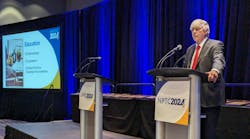Any fleet manager worth his salt knows the basics of shop safety - providing eyewash stations, first-aid kits and safety glasses.
But what about training courses on airborne blood pathogens? Or the symptoms of dehydration? Do your technicians know how to operate a fire extinguisher?
Answering those kinds of questions is what the City of Chicago believes has made its maintenance facilities safer places to work.
"It's the little things that get you," says Chuck Armstrong, technical training specialist for the city's Dept. of Fleet Management. "Take dehydration, for example. Since the first symptom of dehydration is a headache, the first thing someone usually asks for is an aspirin. My first response is: `What did you have to drink today?' They'll say they had a cup of coffee at 7 a.m. Keep in mind that it's now 10 a.m. and the temperature is 90 deg F, with 90% humidity.
"If you're going to work 10 to 12 hours a day in a hot, humid environment, you're going to lose a lot of your body's nourishment through sweat. You have to push fluids on these guys. It's the little things that come back to haunt you when you ignore them."
The same applies to airborne blood pathogens, says Armstrong. "Why is that a concern? Because our guys work on refuse trucks. And these trucks haul everybody's garbage," he says. "Our guys are climbing into the trucks to do repairs; they may look empty, but you don't know what residuals might be in there. We provide plastic surgical-type gloves to minimize their exposure to those kinds of things."
Armstrong also points out that using these gloves also minimizes contact with vehicle oils and lubricants, which can be caustic and sometimes even carcinogenic. He adds that knowledge of such safety topics - though outside the traditional day-to-day concerns of equipment and vehicle technicians - is what creates a better working environment.
"A lot of it is common sense, but I really like to use the phrase `uncommon sense,'" Armstrong explains. "In today's shop environment, you often need uncommon sense to survive. Whether it's teaching our technicians about all the ins and outs of servicing a new piece of equipment or making sure they know how to operate a fire extinguisher, it all adds up to making the shop a safer place to work."
SAFETY MATTERS According to the National Safety Council (NSC), on an average day some 14 people are killed and more than 10,400 disabled on the job. In addition, upwards of 760,000 people die each year from job-related illnesses. The cost to the economy of workplace injuries exceeds $127 billion a year. Among its suggestions are to encourage senior managers of all public and private enterprises to instill a "safety culture" in their organizations.
"Company policy and workstation practice must dictate that safety never take a back seat to other interests," says Jerry Scannell, the council's president and CEO. "No one should be asked to tolerate - and no one should tolerate - a potentially disabling or life-threatening risk in the name of cost-cutting, productivity or any other priority."
Some of those same philosophies provide the foundation for the City of Chicago's Fleet Training Center. Built four years ago in a corner of the city's central maintenance facility, the training center has two classrooms and one office, complete with computers, a video library and a variety of tools to support the fleet management's 800-member staff.
The department has nine maintenance facilities throughout Chicago, in addition to its central shop, which handles major repairs and rebuilds. The central shop also acts as a massive parts warehouse to support the department's 6,000 vehicles and pieces of equipment. It has maintenance responsibility for city services such as streets and sanitation, fire and rescue, and even the equipment servicing Chicago's O'Hare and Midway airports. The police department is the only agency not on its list.
A 25-year-veteran of Chicago's fleet department, Armstrong conceived of the idea for a training center as a way to expand the skill of the department's employees, as well as a way to reinforce what they already know.
"According to statistics I've seen, you retain about 20% of what you see and 40% of what you read and touch. But when you put all three together, you retain about 70%," says Armstrong. "That's why our training is very hands-on."
Technicians are rotated through retraining courses about every two years to keep them current with the industry. "With our time constraints, equipment repair has priority," he says, referring to the 24/7 demand for fire department and snow-removal equipment.
On average, each employee gets 20 hours of training a year on a wide variety of topics, almost all of which has a safety angle.
"Everything is a safety issue," explains Armstrong. "For example, we have new electrical charge capacitors on our strobe lighting units for night work. You need to discharge those before you work on the unit; otherwise, you touch a wire and get a big shock that could throw you across the room.
"Sometimes people focus only on the end result, without paying any attention to how they get there," Armstrong continues. " You need to make sure everything is in sequence, that you're following the process that will let you make the repair properly while also protecting yourself."
The motivation behind Chicago's Fleet Training Center is a simple one: Safety is not just a word; it's a priority.
It's a philosophy that comes from the top - Commissioner Robert T. Degnan, the leader of Chicago's fleet department. Degnan is in many ways the quintessential fleet manager, taking a tough, no-nonsense approach to running his operation. And he's no stranger to the shop floor or the truck cab. A 30-year veteran of Chicago's fleet, Degnan started out as an equipment operator and was appointed commissioner in July 1998.
To his mind, training is an essential ingredient to running a safe shop; without the former, you don't achieve the latter. "We're very aggressive when it comes to training," he explains. "If we don't stay in step with what's out there in terms of new techniques and procedures, we die on the vine. Also, the complexity and diversity of the equipment we support, from airport tugs to 40-ton bulldozers, means our technicians need a wide range of knowledge and skills to maintain them properly and safely."
Degnan adds that he is responsible for supporting 41different city departments, all of which count on him to keep them open for business.
"The only constant we have is change," he says. "Not only are our customers changing the way they operate and the equipment they use, but we're experiencing changes in the types of engines, brakes, transmissions and other vehicle components we maintain. It's like juggling six or eight balls at once. The people in our department are capable of handling it and we give them the latitude to do it.
"But we also want to ensure their safety while doing it. That's where training comes in - it tells our employees we care about them and that we want to invest in them, both to give them more skills and knowledge and let them know how to apply them in the safest way possible."
SOAP To make sure Chicago's fleet training programs hit the mark, Armstrong relies on a simple medical acronym he learned as a Navy medic: SOAP (subjective, objective, assessment and plan).
"I go out in the field and into the shops and get input from our employees; they tell me what they need to know about a problem or situation," he explained. "I watch how they address certain repairs and decide what we need to cover in training. Then I develop a plan to implement it."
Employee input is the key, says Armstrong, because not only will it focus training on what the technicians want to know, but it makes them more likely to volunteer such information in the future.
"This gets back to something our commissioner strongly believes in - employee morale. Our guys are more creative and respond to incentives because training in this format improves morale," he says.
Armstrong uses vehicle heating, venting and air conditioning (HVAC) systems as an example. "You can answer test questions on a form, send it in with $15 or $20 to get your certificate and say, `Yes, I'm certified to work on HVAC.' But that doesn't mean you know how to do it safely," Armstrong emphasizes. "Working on air conditioning systems can be dangerous to your health. So we developed a class for HVAC that includes training on 134 procedures, everything from proper repair techniques to safe troubleshooting."
Armstrong also pointed out that he and Commissioner Degnan are not the only ones doing the work at Chicago's fleet training center. Equipment and vehicle manufacturers play a huge role, sending representatives to conduct hands-on repair and maintenance classes and letting Chicago fleet personnel visit their plants to gain new insights into equipment.
"Working with the manufacturer also helps with the safety aspect," he says. "They know things from an engineering perspective that our technicians might not be privy to. For instance, the Elgin Sweeper Co. showed us a simpler way to break down bearings on their street sweeper brooms. I turned wrenches on sweepers out at O'Hare for 12 years and had never learned that."
Finally, without the input of the fleet's technicians and equipment operators, both training and safety would suffer. "For example, every fall we bring the drivers in and refamiliarize them with the salt spreaders; in the spring, we review sweeper operations," says Armstrong. "We have a long way to go when it comes to doing all the training we need, but we're not just thinking about it; we're putting plans into action.
"Our fleet is so big that we can't assume that everyone coming in the door knows how to do what they need to do," Armstrong continues. "If we can help them gain the skills and knowledge they need, they'll also learn how to protect themselves and make the shop a safer place to work."


